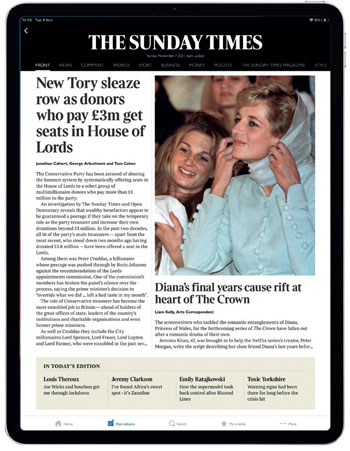
Taneth Evans is a rising star in the world of digital media. In 2020, she was named one of the International News Media Association’s (INMA) ‘30 under 30’, an award recognising excellence in young professionals working in news publishing, for her impressive career trajectory, helping the media organisations she has worked for move from a product-led to an audience-led approach.
In August, Evans was appointed associate editor at The Sunday Times, moving over from The Times, where as head of audience development, she saw dwell time for smartphone app readers increase 25% year-on-year, and the number of digital subscribers surpass print subscribers for the first time (there are now double the number of digital subscribers).
She believes there is no great mystery as to what constitutes an audience-first approach.
“It’s really as simple as putting your readers first which publishers have been doing for decades. The difference in the age of digital journalism is you no longer have a single, homogenous audience.”
Today’s audience might come to a story from a newspaper’s own platforms, from social media, aggregators, or a shared link in an email or WhatsApp message.
“They don’t have the same needs, so it’s down to us to think about who we’re talking to and which needs we’re fulfilling when we’re creating our journalism,” she says.
At The Sunday Times, we are informed by data but not dictated to by it.
Audience-first
Evans believes an audience-first approach requires a change of emphasis, thinking about who a story is for and what needs are being met before making more traditional product-led decisions such as what it will look like, whether there will be multimedia elements, and what time it will be published.
“Decisions like formats and platforms come easily when you’re putting your audience first, in my opinion. It makes sure you’re telling the story in the best possible way for the right audience rather than making a video because you want to make a video,” she says.
The way in which we think about audience also needs to shift from categorising by demographics to looking at interests, believes Evans.
“I think it can become slightly lazy when we start to segment by age or gender, especially when it comes to news. I think, instead, it’s much smarter to think about your audience in terms of interests, needs, passion points, mindset, all of the more behavioural things.”
The key is to think about what a story is there to do, she says. For example, if it is intended to convey new information, is that information clear enough and can the reader find the facts? If it is meant to entertain, does it do that in a compelling fashion? No one approach fits every story, meaning each must be assessed as an individual product.
“Moving our mindset away from the traditional modular news reporting that we’re used to and understanding the job a story is doing really allows us to put ourselves in the shoes of our readers and imagine their mindset when they’re consuming what we’ve created so we can make the best thing for that moment,” she says.
In practice, this means re-educating reporters and commissioning editors to have more empathy for their readers, asking who a story is for and what they are trying to do with it, rather than thinking ‘I hope this story gets onto Page 3’ or ‘I hope this one will run and run’.
This doesn’t mean eschewing editorial judgement, which Evans sees as more important than ever.
“We’re giving people a lot of information and without the editorial judgement that is applied on top of that, we’d be in a Wild West.”
When it comes to The Sunday Times in particular, Evans believes they have made great progress with thinking about the purpose of each story and using data to understand their audience but admits there is more to be done.
“The job will never be done when it comes to digital storytelling because it’s always moving on, so the challenge for us is to stay steady on our strategy and the foundations of excellent digital journalism while also being nimble enough to improve our tactics while the landscape changes around us.”
In the age of digital journalism, you no longer have a single, homogenous audience.
Measuring the right things
The Sunday Times has its own proprietary data service, specifically designed to give newsrooms access to the metrics that matter, using indices to allow editorial staff to compare what can often be quite complex data sets. For example, they have created something called the ‘dwell time index’ which takes into account a number of factors such as word count, images, and what device people are reading on, and comes up with a prediction as to how long readers should spend reading a piece. If, on average, readers are spending longer, you get a high score on the dwell time index and if they are spending less time, then you get a lower score. It gives the newsroom a context which they wouldn’t have if they were just looking at the raw time spent on a page.

Evans is at pains to point out they would rarely use data to make a single decision, but rather to pick out patterns and trends.
“At The Sunday Times, we are informed by data but not dictated to by it. Editors still make their own decisions, but they use the data to help guide them,” she says.
However, she firmly believes data is the best tool for news publishers looking to understand their audience better.
“We’re just so incredibly lucky to be able to have such insight into our readers’ wants and needs. Data is your readers. There’s no better way to understand them than to be able to listen to them, to their behaviour. Don’t write that off, don’t get scared of it and don’t dismiss it. Not using data at all to help you make your decisions is like having readers in your pocket and not listening when they talk.”
She is also a passionate champion of the new audience development skill sets, such as writing for social, optimising for search, putting together a newsletter and writing a push notification, insisting these are as important to today’s media businesses as more traditional skills such as copy-editing.
It can become slightly lazy when we start to segment by age or gender, especially when it comes to news.
Content audit
In her previous role as head of audience development at The Times, she oversaw a giant audit of their journalism, known internally as the ‘Content Review’, in which they looked at a huge cross section of content, organising it in terms of all the editorial decisions that had been made from commissioning to publishing, then matching that up with performance data to understand what works and what doesn’t.
She says: “We learnt a lot from the project and it allowed us to pick up discussions around what now forms the basis of our strategy and that is tell it well, do fewer stories better. Being able to instil some top line messages like those was really effective and the newsroom took it on board really successfully.”
Culture change takes time and as part of this process, she and her team learnt that a ‘big bang’ presentation isn’t enough. You need to reinforce these messages by constantly repeating them and working in smaller groups. But the hard work has paid off and the result is that on The Sunday Times and The Times, they have “instilled a real focus on distinctive journalism”.
“At The Sunday Times, we say all of our journalism must be unmissable. Tell it well, think about your narrative, think about the people involved in your story. We’re also thinking about doing fewer stories but better online,” says Evans.
An example of this is the print nibs, which they dropped from the online version of the paper as they realised the time could be better spent making other stories ‘sing’. This can be as simple as adding a case study, making sure the right person is telling a story, or using a more complex tool such as a postcode finder in a story about air pollution allowing the reader to check air pollution levels where they live.
The job will never be done when it comes to digital storytelling because it’s always moving on.
Content marketing
Evans did not train as a journalist, but began her career at iCrossing, a global digital marketing agency owned by Hearst, which allowed her to hone her skills in content marketing.
“I learnt about social marketing, SEO and, importantly, creating content for a defined purpose and I think it’s that which makes me look at journalism slightly differently.”
She joined The Times as SEO Editor in 2016, moving in 2018 to become head of audience development overseeing SEO, social media, newsletters, push reader engagement, community journalism and audience strategy.
In her new role, she is working across all sections of The Sunday Times and she is really keen to showcase the breadth of content alongside the “bread and butter” of news. One thing they did recently was to pull the News Review section of the print paper into the news section online.
“We want to offer a real breadth of news and opinion in the same space and so that’s a really good example of us being more creative, moving away from the traditional print taxonomy and instead thinking how a reader can view this, rather than building our digital products on how our paper looks,” she says.
She adds: “We’re no longer competing only with other Sunday newspapers, we’re competing with global news providers, we’re competing with social media companies, news aggregators and on many levels, we’re competing with the whole of the internet for our readers’ attention. Our aim is to become the best in the business.”
We’re competing with the whole of the internet for our readers’ attention.
This article was first published in InPublishing magazine. If you would like to be added to the free mailing list, please register here.












